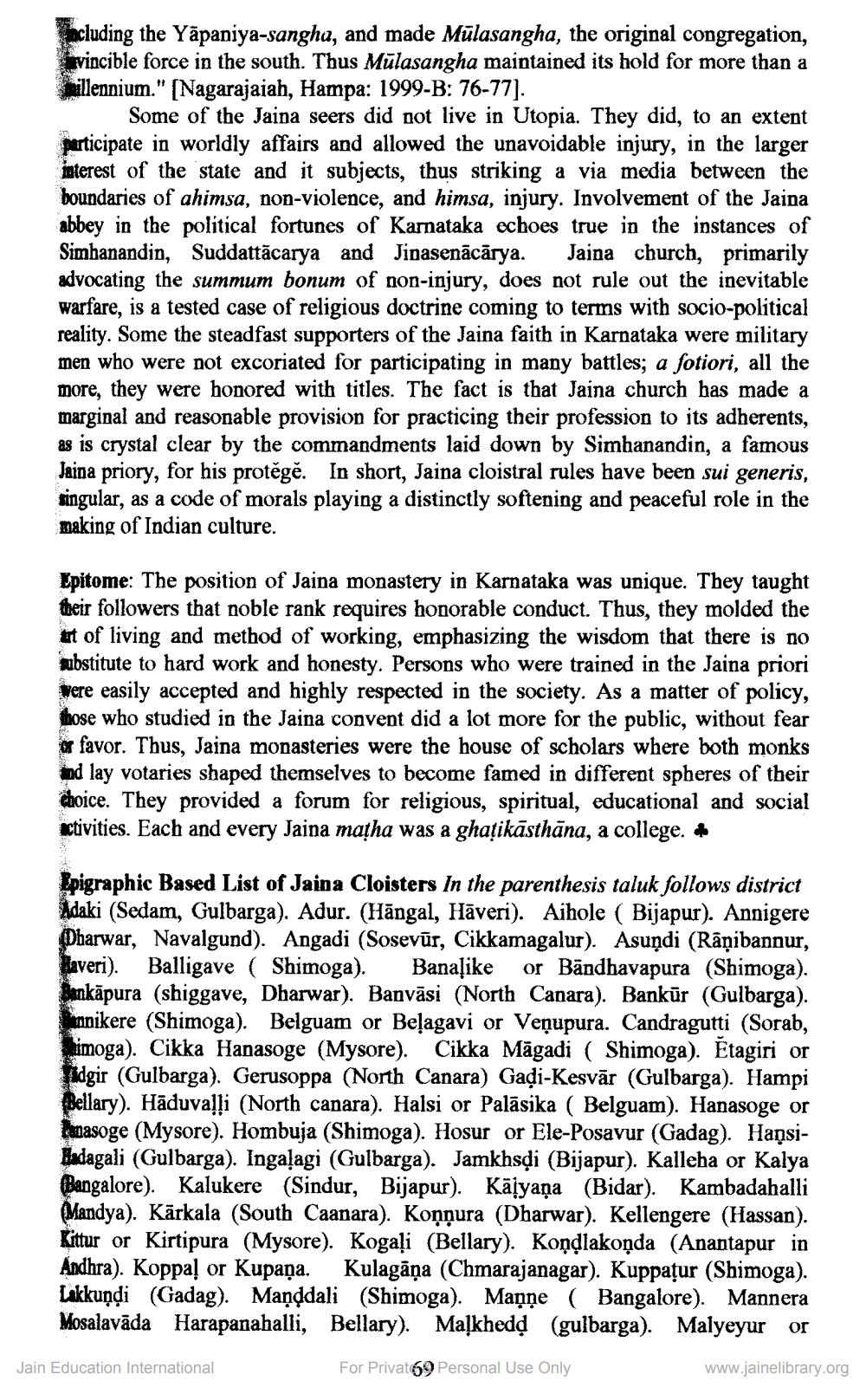________________
ancluding the Yāpaniya-sangha, and made Mülasangha, the original congregation, nvincible force in the south. Thus Mülasangha maintained its hold for more than a millennium." [Nagarajaiah, Hampa: 1999-B: 76-77).
Some of the Jaina seers did not live in Utopia. They did, to an extent participate in worldly affairs and allowed the unavoidable injury, in the larger interest of the state and it subjects, thus striking a via media between the boundaries of ahimsa, non-violence, and himsa, injury. Involvement of the Jaina abbey in the political fortunes of Karnataka echoes true in the instances of Simbanandin, Suddattācarya and Jinasenācārya. Jaina church, primarily advocating the summum bonum of non-injury, does not rule out the inevitable warfare, is a tested case of religious doctrine coming to terms with socio-political reality. Some the steadfast supporters of the Jaina faith in Karnataka were military men who were not excoriated for participating in many battles; a fotiori, all the more, they were honored with titles. The fact is that Jaina church has made a marginal and reasonable provision for practicing their profession to its adherents, as is crystal clear by the commandments laid down by Simhanandin, a famous Jaina priory, for his protégě. In short, Jaina cloistral rules have been sui generis, singular, as a code of morals playing a distinctly softening and peaceful role in the making of Indian culture.
Epitome: The position of Jaina monastery in Karnataka was unique. They taught their followers that noble rank requires honorable conduct. Thus, they molded the ut of living and method of working, emphasizing the wisdom that there is no mbstitute to hard work and honesty. Persons who were trained in the Jaina priori were easily accepted and highly respected in the society. As a matter of policy, those who studied in the Jaina convent did a lot more for the public, without fear or favor. Thus, Jaina monasteries were the house of scholars where both monks and lay votaries shaped themselves to become famed in different spheres of their choice. They provided a forum for religious, spiritual, educational and social activities. Each and every Jaina masha was a ghaţikāsthāna, a college. do
Epigraphic Based List of Jaina Cloisters In the parenthesis taluk follows district Adaki (Sedam, Gulbarga). Adur. (Hāngal, Hāveri). Aihole ( Bijapur). Annigere Dharwar, Navalgund). Angadi (Sosevūr, Cikkamagalur). Asuņdi (Rāṇibannur, Haveri). Balligave ( Shimoga). Banaļike or Bändbavapura (Shimoga). Hankāpura (shiggave, Dharwar). Banvāsi (North Canara). Bankūr (Gulbarga). hanikere (Shimoga). Belguam or Belagavi or Veņupura. Candragutti (Sorab, Limoga). Cikka Hanasoge (Mysore). Cikka Māgadi ( Shimoga). Étagiri or fidgir (Gulbarga). Gerusoppa (North Canara) Gaçi-Kesvār (Gulbarga). Hampi Bellary). Hāduvaļļi (North canara). Halsi or Palāsika ( Belguam). Hanasoge or twasoge (Mysore). Hombuja (Shimoga). Hosur or Ele-Posavur (Gadag). HaņsiHadagali (Gulbarga). Inga!agi (Gulbarga). Jamkhsdi (Bijapur). Kalleha or Kalya Bangalore). Kalukere (Sindur, Bijapur). Kāļyaņa (Bidar). Kambadahalli Mandya). Kärkala (South Caanara). Koņņura (Dharwar). Kellengere (Hassan). Kittur or Kirtipura (Mysore). Kogaļi (Bellary). Kondlakonda (Anantapur in Andhra). Koppaļ or Kupaņa. Kulagāņa (Chmarajanagar). Kuppațur (Shimoga). Lakkuņļi (Gadag). Maņddali (Shimoga). Maņņe ( Bangalore). Mannera Mosalavāda Harapanahalli, Bellary). Malkhedd (gulbarga). Malyeyur or
Jain Education International
For Privat69 Personal Use Only
www.jainelibrary.org




